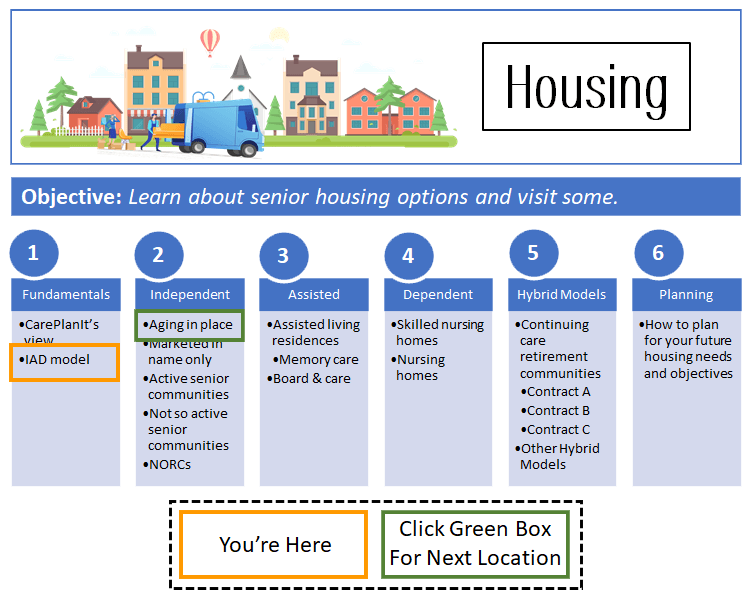Senior Housing Made Easy
Click here to see what's on this page.
Senior housing appears complicated because the senior housing industry’s marketing messages are confusing. However, there are only three ways to live. Therefore, if you stay focussed on these you’ll cut through the marketing messages and get the answers you need to make better choices.
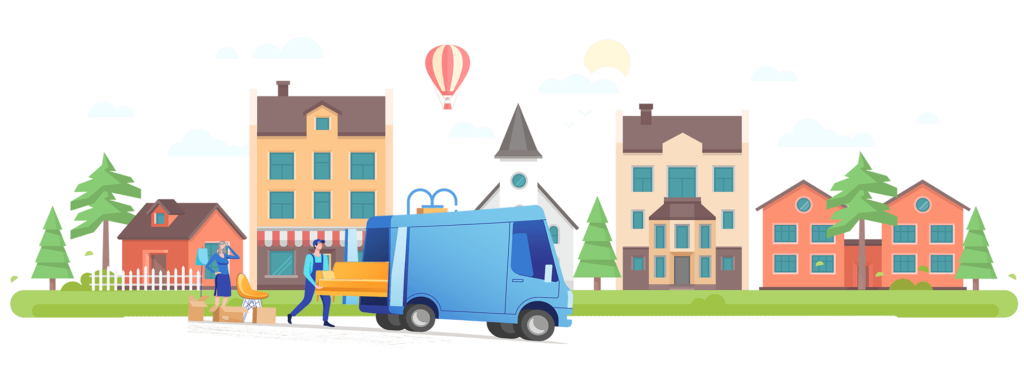
Quick Tip
There are only three ways to live:
> Independent
> Assisted
> Dependent
Senior Housing Falls Into 3 Categories: Independent, Assisted & Dependent
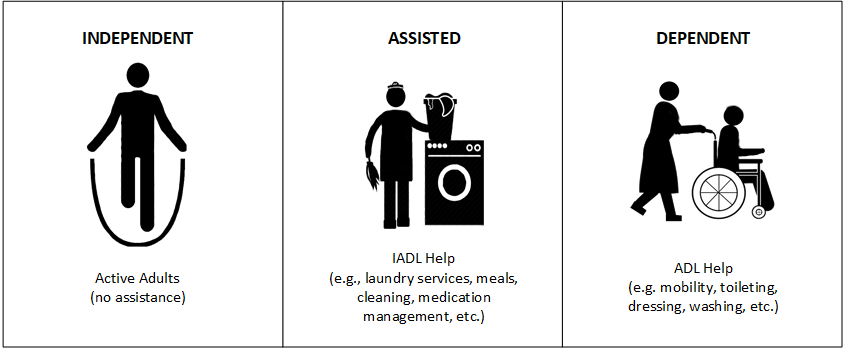
CarePlanIt makes housing definitions easy. We also believe our definitions allow Agers, their family, and their Caregivers a better way to evaluate, select, and manage their housing choices. We define housing in terms of the needs of the senior. That’s the same way the government defines senior housing for reimbursement purposes.
Independent Senior Housing
For example, independent senior housing, or living, means you can live on your own without help. You can perform all instrumental activities of daily living (IADLs), and all your activities of daily living (ADLs). Learn about these here. For example, think about the abilities you’d need to raise children. If you have all of these abilities, living independently is a breeze.
How Are Independent Senior Housing Options Described?
The senior housing industry describes independent living options with terms like active senior community, active adult community, independent adult community, and independent living. These terms do not describe seniors needing assistance. In other words, “active” means independent. You need to know that these communities and environments are not interested in assisting seniors. However, it doesn’t mean that assistance can’t be found, only that it is not the primary focus of this type of senior housing environment.
Anytime a community focuses on “active” and “independent,” they’re sending a subtle message that they don’t want seniors who have any long-term needs for assistance. There are lots of reasons communities choose this option. But the primary reasons are they want to promote amenities active seniors want, like exercise, sports, and leisure (pools, trails, etc.), and not on assisted services like meals, transportation, health care, and rehabilitation services.
You need to know what this implies because if you or your spouse has any type of debilitating chronic condition or family history with these types of conditions, an active adult community will not address these needs. Active communities tend to be light on sidewalks, wheelchair ramps, and transportation options.
In some cases, you’ll see the term “active seniors” combined with “free transportation” and “senior busses available.” If all the facility provides is supplemental transportation, they still fall into an independent living provider.
Risks To Seniors In Independent Housing Environments
We discuss these in greater detail here, however, the most significant concerns are clauses or conditions in rental agreements or homeowner association covenants that interfere with assisted services. In independent living environments, you often find legal agreements that preclude long-term overnight guests (including caregivers), building handicap ramps, maximum resident restrictions, bans on multi-family occupation, and non-resident parking restrictions. All of these make it difficult to stay in this type of housing if you need long-term help.
How Are Assisted Senior Housing Options Described?
Assisted senior housing options are described by the senior housing industry using terms like “assisted living,” “assisted living residences,” and “board and care.” In most cases, these facilities are designed and legally zoned for varying levels of permanent help. We discuss these options in detail starting here.
Technically, assisted living environments provide various levels of IADL support. This includes things like meal services, onsite health care, cleaning services, transportation, laundry services, and medication management. Occasionally they may help with one or two ADLs, like bathing or grooming. But they stop short of providing help with anything more. ADL levels of support subject them to different levels of regulation and requires higher staffing levels.
RISKS TO SENIORS IN Assisted HOUSING ENVIRONMENTS
Other than poor care, the biggest risk for seniors in assisted living environments is falling below the required ability threshold. Seniors in assisted living environments must meet basic levels of capabilities. They generally need to be able to dress and eat, get around on their own, and use the restroom. Without these abilities, seniors require nursing home-level care.
When senior physically or cognitively declines to a level where they cannot perform their ADLs, they are usually asked to leave. Occasionally, the assisted living facility also offers nursing-level care. But generally, assisted living facilities will stop short of providing ADL support.
How Are Dependent Senior Housing Options Described?
The senior housing industry describes dependent living options with terms like “nursing home,” “skilled nursing home,” and “long-term care facilities.” All these types of facilities are subject to government regulations. To generate more revenue, many dependent living facilities offer rehabilitative services. Today, these are the majority of dependent living facilities. They’re called skilled nursing facilities or SNFs (pronounced “Sniffs”).
What all dependent living facilities have in common is the resident’s inability to perform ADLs. ADLs are lost temporarily or permanently. The most common scenario of a temporary loss of ADLs is when a senior falls and breaks a leg. They are hospitalized for a day or two and then sent to a SNF for rehabilitation. When they regain their ability to perform most or all of their ADLs, they’re sent home
We’re focussed here on dependent living which implies a permanent loss of abilities. Most seniors that have lost the ability to perform their ADLs are in SNFs or nursing homes. Nursing homes provide ADL support but don’t have the skilled professionals or certifications necessary to provide rehabilitative services.
RISKS TO SENIORS IN Dependent HOUSING ENVIRONMENTS
Other than poor care, the biggest risk for seniors in long-term dependent living facilities is being evicted or removed for aggressive or violent behavior. The resident of often sent a psychological holding facility for evaluation. These can be terrible places. If the resident is gone from the dependent facility for more than seven days they can lose their place.
What Makes Senior Housing Facilities Legitimate?
The senior housing industry has created thousands of housing options. The names they use are often the same. But the underlying housing can be very different. A “Senior Community for Active Adults” can mean a planned community on a lake with a golf course, or a fifty-year-old apartment complex in the middle of a city. How is an urban apartment building anything like a suburban golf course environment? “Senior housing” can mean a legally qualifying senior community or a run-down apartment trying to market themselves as a relatively safe environment because they house seniors.
Carmen and I have looked at hundreds of adult housing facilities. From senior villages to skilled nursing homes. The way these facilities are described is confusing and very often overlapping. We’ve found that we, as Agers, must first determine the way we plan to live before we can understand a senior living facility. In other words, the first step is asking “Are we living independently, with assistance, or dependently.” See and review the Health Section here to determine where you are now, and where you might be in the future.
Honesty Results In The Best Choices
We noticed that we delude ourselves if we say yes, and only yes, to independent living. If I don’t consider my need for assistance in the future, I’m not thinking rationally about what life might be like five or ten years from now. I also need to consider that what I don’t want today, I might be willing to consider tomorrow. The reasons are many, but often involve health, the costs of staying in my current home, or the condition of a spouse. In other words, life will change.
Denying that change happens, doesn’t make change any less likely. In fact, it probably hastens the change. The good news is that understanding housing options allows us to make better decisions in the future. If we always think in terms of our abilities and corresponding needs, these housing choices will make more sense.
Stay Focused on The Three Ways To Live
When you focus on the three categories of living: independent, assisted and dependent, you start considering how housing intersects with your health. If I have replacement hips and have trouble walking today, it’s pretty safe to assume I’ll need assistance with mobility in the future and all the ADLs and IADLs that require mobility.
This doesn’t mean I can’t live in my own home. What it means is I need access to someone to assist me with mobility. If I have the finances, I can hire my own helper. Where I live doesn’t matter all that much because I can simply turn my home into an assisted living facility. If I don’t have the resources, I may have a child that is willing to move in with me and help me with mobility. Alternatively, I may consider moving to a home close to a child. I can also stay in my own home, but get extra help when I need it.
Ask The Right Questions
When looking at senior housing facilities, our best practice is that you consider:
> Services – what does the facility provide in terms of services, and
> Community – does it maintain a legally defined adult community?
By looking at services, you can assess how long you might be able to stay in that facility. By considering legally defined adult communities, you can have a higher level of confidence that you’ll get adult services and that these services will be available in the future. Non-legal adult communities are using marketing techniques, and are not as likely to adhere to the legal requirements of a legal senior community. If you use this as a framework, you’ll be less confused by names.
Senior Housing Is A Senior’s Number One Concern
As we explained above, staying in our own home is our number one concern as an Ager. Let’s face it, if moving was fun or something Agers enjoyed, we’d be doing it. We don’t. We really hate moving. It takes a lot of work, it’s disorienting, it’s emasculating (or defeminizing), and it’s culturally taboo.
Seniors hate moving so much their preferred way to travel is to bring, literally, their house (or their bedroom and living area) with them. Seniors’ favorite ways to travel are cruise ships and motorhomes: where we can take our home on the road.
This said, regardless of the home we’re in now, or might be in in the future, we should understand the best way to evaluate what type of home is best for us. Knowing what type of home is best allows us to make better choices. If we choose to stay in our home, we know what changes to make. If we choose to move, we know what options are best.
Use IAD For Housing Evaluation & Selection
There are only three ways to live: independent (I), assisted (A) or dependent (D). We call it the IAD housing model.
- Independent, or
- Assisted, or
- Dependent
Regardless of what the senior housing facility calls itself, you can focus on the services they provide. Based on those services, they fall into one of the IADs.

Where you fall in this scale changes over time. Sometimes your health will hasten your need for services. Generally, as we age, the level of care we need goes up.
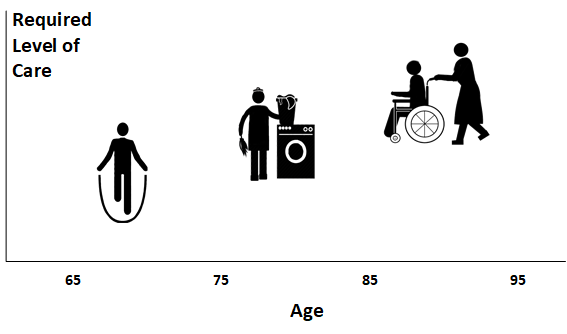
Even In My Own Home – The IAD Model Should Be Followed
It’s important to know the levels of care we’ll need even if we plan on staying in our own home until we die. Knowing what we may need helps us save the money needed to allow us to stay in our home. If we can’t save or don’t want to save the necessary money, and expect our family to step in, we can let our family know that we’ll be turning to them for support. This gives them notice so they can plan accordingly.
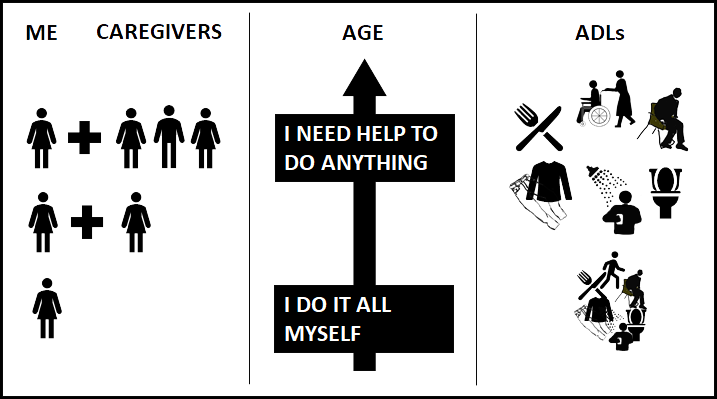
CarePlanIt focuses on these definitions because they tie into our definitions of Health and Finances. As our health declines, we need more assistance. The kinds of assistance are defined by the ADLs and IADLs we cannot do for ourselves.
To get this assistance, we need money or access to additional resources. If you have lots of money or access to resources, you can acquire the assistance you need and turn your house into the equivalent of an assisted living facility or nursing home. You can’t skip this reality. As your health declines, things need to be done that you can’t do. If you want to age in place, you’ll be turning your home into an assisted living facility, and ultimately, into a nursing home.
Know Your Capabilities
How I can live requires me to know my capabilities and how these capabilities will change over time. As my capabilities decline, I need more help. I go from independent living, to assisted, and from assisted to dependent. If I live long enough, I will experience each level of need. Click here to see what types of housing fall into these categories.
The senior care industry defines a senior’s functionality around one’s ability to perform everyday tasks. These tasks tie into the three levels of living. They’re called “activities of daily living” and “instrumental activities of daily living.” These tasks are covered in the Health Section of this book.
Carmen and I learned that Super Agers know their living options are tied to their functionality. They use this knowledge to assess the best living environments.
Other Resources On Senior Housing
Interesting article on senior housing options here.
Good article on minorities and senior housing here.
